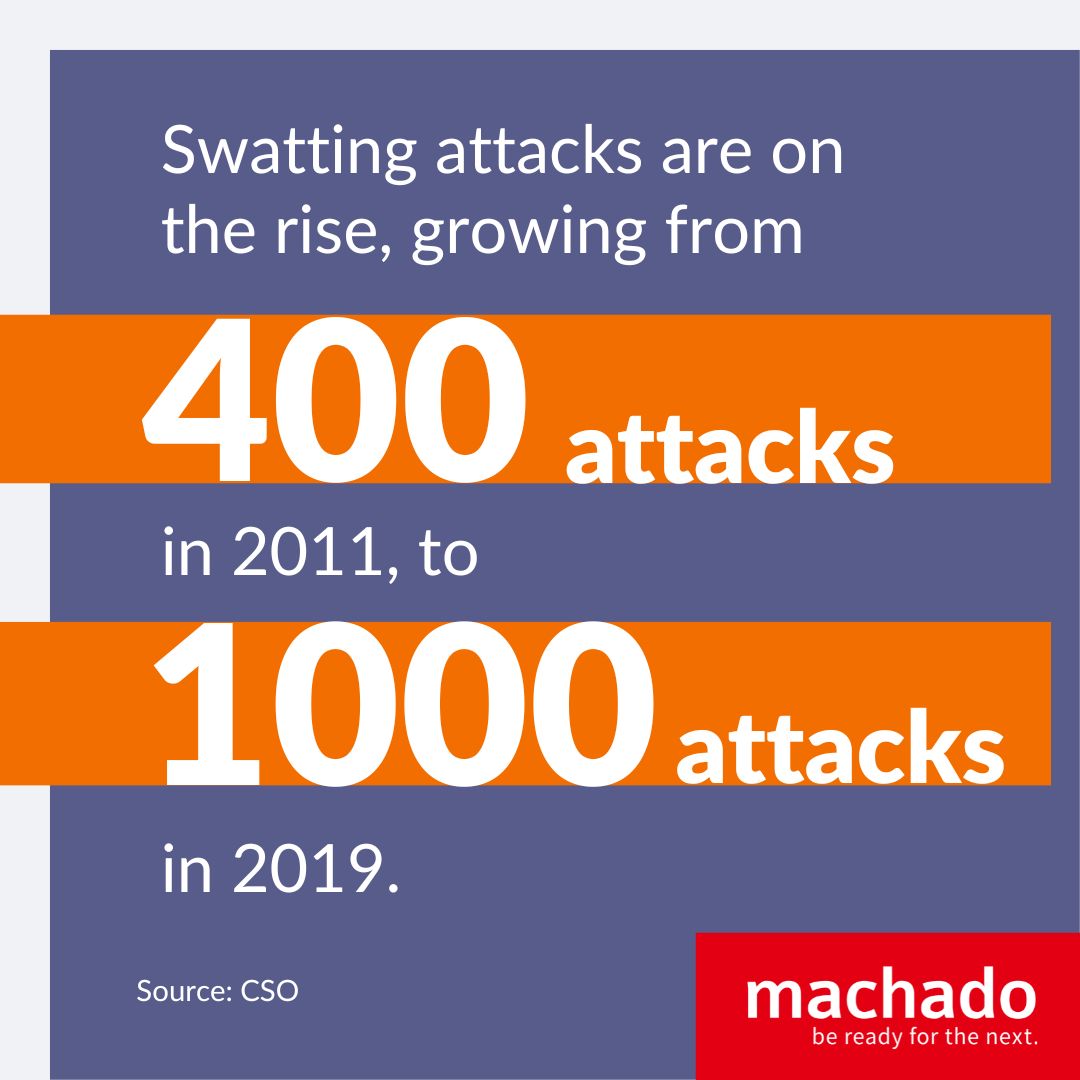TL;DR: Swatting Attacks are the latest in a newer breed of cyber threats that could impact your businesses. In this blog, we examine a detailed, real-world case study that illustrates the effects these attacks could have on your operations, client trust, and overall business reputation. Lastly, we provide an overview of essential protective and proactive measures your business can implement to help safeguard against swatting attacks.
A New Threat Emerges: Swatting Attacks Are A Creative and Concerted Effort
Reported on only a year ago by CSO, swatting attacks on businesses are becoming more prevalent.
“Swatters use data brokers and stolen information on the dark web to target C-suite and board members. Removing personal information from the web is the best way to minimize this risk.”
Take a moment and imagine the following (somewhat) fictional scenario:
It’s a typical Tuesday morning at ‘Legal & Lawful’, a fictional legal firm specializing in corporate law, and you’re settled in as the firm’s IT manager. With your second cup of coffee in hand, you’re immersed in reviewing the system’s logs from the previous night. The familiar, quiet office environment is suddenly disrupted when Lisa, one of the senior partners, appears at your door with an unusual expression of concern.
“Morning,” she greets you, her tone filled with worry. “Have you seen what’s happening outside?” Before you can respond, she continues, “The police are here, right in our building!”
As you step out to see for yourself, the scene unfolds with a surreal quality. SWAT officers are moving through your firm, responding to what you soon learn is a swatting incident.
A false report claimed there was a hostage situation right at ‘Legal & Lawful’. The intensity of the situation escalates as the police, operating under the assumption of a real threat, conduct their operation.
What you don’t realize is that you’re in the middle of a swatting attack.
What Is a Swatting Attack?
Swatting is a form of harassment where someone makes a false report to emergency services to send police or SWAT teams to an unsuspecting victim’s address (in this case, your firm), and can have significant cybersecurity implications for professional services.
Attackers often use data they’ve acquired on the dark web to target and attack personal and professional victims.
A Swatting Attack can have severe professional and personal consequences on businesses.
These might include:
Employee Safety and Trauma: The immediate concern is the safety of everyone in the building. The presence of SWAT officers, particularly if they enter with weapons drawn, can be extremely frightening and traumatic. Employees could suffer both physical injuries in the confusion and long-term psychological impacts, such as PTSD.
Disruption of Business Operations: The police response will likely disrupt the firm’s operations. Employees may be evacuated or forced to remain inside their offices, causing significant work delays. Important meetings or deadlines could be missed, impacting client service and ongoing legal proceedings.
Damage to Property: SWAT operations, given their nature, can sometimes involve forced entry into rooms or offices and may result in property damage. This could mean broken doors, damaged office equipment, or other harm to the firm’s physical assets.
Reputational Damage: The presence of a SWAT team at a legal firm can attract media attention and public curiosity. Even if the firm is not at fault, the association with a police action can harm its reputation, potentially leading clients to question the firm’s reliability or safety.
Client Confidentiality and Privacy Concerns: If the police operation involves searching through offices and accessing computers or files, there could be concerns about client confidentiality and privacy breaches. This could have legal implications and damage client trust.
There are more, and we’ll cover that in more detail later.
This direct encounter with a swatting attack shifts the firm’s focus towards a deeper understanding of such threats and their significant impact on businesses, especially those in professional services. Digital security demands continuous proactive measures to protect not just data, but also the physical safety of everyone in the firm.
What Are Swatting Attacks’ Effects on Professional Services SMBs
Cyber swatting attacks first started in the early 2000s, and have grown ever since. This phenomenon, where emergency services are falsely alerted to a non-existent threat at a business location, can have far-reaching implications.
Notably, it puts the firm’s hard-earned reputation and the trust of its clients at risk. Trust and Reputation are the most crucial assets of any firm.
Once compromised, it can be difficult to restore, highlighting the need for a proactive approach against swatting.
Reputation and Client Trust
In professional services, your reputation is everything. The trust clients place in your firm is hard-earned and easily lost.
Cyber swatting poses a unique threat to this trust. The spectacle and drama of a swatting incident can quickly become public, raising questions about your firm’s security measures and the safety of client information.
Such events can lead to a loss of confidence among clients, who may wonder if their sensitive data is at risk in a firm that becomes the target of such attacks.
Managing public perception in the wake of a swatting incident is challenging and requires a transparent, well-considered approach to reassure clients of your commitment to their safety and the security of their information.
Operational Disruptions
The immediate aftermath of a cyber swatting incident can be chaotic. Emergency responses, such as evacuations or lockdowns, disrupt the normal flow of work, leading to lost productivity and potentially missed deadlines.
Beyond the immediate incident, there may be a lingering atmosphere of fear or unease among employees, impacting morale and effectiveness.
Additionally, the firm may need to allocate time and resources to investigate the incident and strengthen security protocols, diverting attention from core business activities. Ensuring employee well-being and maintaining operational continuity in the face of such disruptions are key challenges for any IT manager in this sector.
The Financial Implications of a Swatting Attack
The financial costs associated with a cyber swatting incident can be significant. Direct costs include potential damages to physical infrastructure during the emergency response, legal fees, and expenditures on additional security measures.
There are also indirect costs, such as the loss of business during and after the incident, and possibly increased insurance premiums.
For an SMB, where resources are often more limited, these costs can have a substantial impact on the bottom line. Being prepared with a comprehensive cyber insurance policy is essential to mitigate these risks.
Legal and Compliance Risks
Cyber swatting incidents may also expose your firm to legal and compliance risks. If client data is compromised or mishandled during the response to a swatting incident, the firm could face legal action for breach of confidentiality or non-compliance with data protection regulations.
Additionally, there may be a need to cooperate with law enforcement investigations into the incident, requiring time and resources. Staying informed about legal obligations and ensuring compliance with data protection laws are crucial for safeguarding against these risks.
When we think about cyber swatting, it’s not just about the immediate scare or confusion it causes.
For a small or medium-sized business in professional services, the fallout can be much more significant. It’s not only a matter of dealing with the chaos of the moment but also handling the aftermath.
In this section, we’ll break down these issues one by one to see just how deep the impact can go and why it’s something we really need to be prepared for.
Swatting Case Study: CISA Director
Theoretical knowledge must be complemented with practical insights. This is where real-world examples and case studies become invaluable.
The following swatt attack examples and case study brings to life the risks and ramifications of cyber swatting while also serving as a powerful reminder of the importance of being prepared. By studying these examples, we can gain a deeper understanding of how to effectively implement the strategies discussed and how to fortify our businesses against such digital threats.
As with many cyber threats, swatting began with a personal attack, and has since escalated.
The Jen Easterly Incident: A Swatting Target
The case of Jen Easterly, Director of the Cybersecurity and Infrastructure Security Agency (CISA), stands as a real-life example of swatting. Easterly’s home was targeted in a swatting attack, involving a false 911 call claiming a shooting at her residence. This incident is a vivid example of how swatting has evolved to target not just individuals or businesses, but also high-profile government officials.
This incident underscores the indiscriminate nature of swatting, where anyone, regardless of their public standing or recognition, can become a target. It highlights the significant risks involved, including the personal safety of the targeted individual and the unnecessary strain placed on emergency services.
Broader Implications of Swatting Attacks for Public Figures and Officials
Following the incident, Easterly’s response brought attention to a broader pattern of harassment and swatting against public figures, swatting attempts have affected numerous congress members, Maine Secretary of State, and even current presidential candidates. This trend has serious implications, showing the need for a comprehensive understanding of what are swatting attacks.
Swatting Attacks on the C-Suite and BOD
Yet another example is a swatting incident that occurred in Groveland, Massachusetts, on February 1, 2023. Around 8:45 pm, a hoax call was made to 911 claiming harm was done to someone in a home on Marjorie Street, and threats were made against first responders. Groveland’s police chief, Jeffrey Gillen, responded by coordinating with nearby towns for emergency support.
However, it was soon discovered that the call was a false alarm. No arrests have been made in connection with this incident. This event in Groveland is part of an increasing trend of swatting attacks in the U.S., as evidenced by recent threats against schools in Michigan and Southern California. Swatting, named after SWAT (Special Weapons and Tactics) police units, is a dangerous hoax that can lead to serious injuries or fatalities.
As noted in the CSO article, “What we’re seeing right now is very, very different,” Chris Pierson, a former DHS advisor and the founder and CEO of BlackCloak, tells CSO. “It’s a coordinated precision attack against corporate executives.” Source.
Easterly’s case, along with other incidents targeting C-Suite execs, government and public officials, shows the critical need for effective response strategies and legislative measures to combat swatting. It’s a clear call for all professional sectors, not just government, to recognize the risks of swatting and to develop plans to address this growing threat.
A Detailed Guide on Preventing and Preparing for a Swatting Attack
As we’ve seen, the consequences of cyber swatting attack can be serious for small businesses, affecting everything from client trust to legal compliance. These attacks are on the rise, growing from 400 instances in 2011, to 1000 swatting attacks in 2019.
But it’s not all doom and gloom, there are effective steps you can take to reduce these risks.
Each of the following steps plays a crucial role in building a comprehensive shield against the unique threats posed by cyber swatting.
Elevate Your Cybersecurity Approach
For businesses in the professional services sector, effectively guarding against cyber swatting and other attacks involves a proactive and comprehensive approach to Cybersecurity. This means going beyond basic security measures.
Network Security with Firewalls and Intrusion Detection Systems (IDS):
Firewalls: Act as a gatekeeper for your network, controlling incoming and outgoing network traffic based on an applied rule set. A strong firewall setup can effectively block unauthorized access, malicious traffic, and manage data flow in and out of your network.
Intrusion Detection Systems: IDS monitor network traffic for suspicious activity and known threats, alerting you to potential breaches. They play a crucial role in identifying unusual patterns that could indicate an attack.
Regular Software Updates:
Keeping software up-to-date is critical. Software updates often include patches for security vulnerabilities that have been discovered since the last version. By regularly updating, you reduce the risk of attackers exploiting known vulnerabilities.
Access Control:
Restricting access to sensitive data is crucial. You should implement policies where employees only have access to the data and resources necessary for their role. This principle, known as “least privilege,” minimizes the risk of internal data breaches and reduces the potential damage if an account is compromised.
Multi-Factor Authentication (MFA):
MFA requires users to provide two or more verification factors to gain access to a resource such as an application, online account, or a VPN. This significantly reduces the chance of unauthorized access, even if usernames and passwords are compromised.
Cybersecurity Awareness Among Employees
Your team’s awareness and response to Cybersecurity can significantly influence your firm’s ability to prevent and manage cyber threats. It’s vital to ensure that everyone understands the importance of Cybersecurity in their daily roles.
Regular, engaging training sessions should be a staple, focusing on current cyber threats and their indicators, including those related to swatting attacks. Realistic drills and simulations can be particularly effective. These exercises should clarify procedures for reporting any unusual activities. Encouraging this level of proactive reporting can greatly improve your firm’s overall Cybersecurity.
When employees are well-trained and alert, they form a critical part of your business’s defense strategy, safeguarding both operational integrity and client trust.
How to Create a Swatting Incident Response Plan
An effective response plan for swatting incidents is essential for any professional services firm. This is why it’s important to develop a Cyber Incident Report, with standard procedures that are regularly practiced.
Begin by designating a response team. These are the people who will take charge during a swatting incident. The plan should outline specific steps to verify the legitimacy of a threat, such as who to contact and how to quickly and safely assess the situation.
It’s also important to include clear communication protocols, both internally and with law enforcement. Regularly practicing this plan through drills will ensure everyone knows their role and can act swiftly and efficiently if an incident occurs.
Ensure Legal Preparedness and Compliance
Staying legally prepared and compliant is crucial, especially when it comes to handling personal and sensitive client data. Regular consultations with legal experts can help you stay informed about your legal obligations and any new compliance requirements. This includes understanding how to legally handle a swatting incident and the aftermath, especially if client data is involved.
A legal expert can also advise on the best practices for documenting and reporting such incidents, ensuring that your firm’s response is not only effective but also legally sound.
Fortifying Your Swatting Attack Defenses: Partnering with An MSSP Like Machado
Cybersecurity can be overwhelming, especially with threats like cyber swatting on the rise. For businesses in the professional services sector, this is where the role of Managed Security Service Providers (MSSPs) becomes crucial.
They act not just as external support but as strategic partners, offering specialized expertise and tools to manage your IT infrastructure. With an MSSP by your side, the complex task of safeguarding your digital assets becomes more manageable, freeing you to concentrate on your core IT activities.
Customized Security Solutions and Proactive Monitoring
When it comes to cyber swatting and other attacks, off-the-shelf definitely doesn’t cut it. By understanding the specific risks and challenges your firm faces, Your MSSP can set up defenses that are much more effective than generic, off-the-shelf solutions.
Cybersecurity solution providers actively monitor your network, constantly on the lookout for any signs of trouble, including the early warning signs of a cyber swatting attempt. This kind of proactive monitoring means potential threats can be identified and dealt with quickly, minimizing their impact on your business.
Legal Compliance and Emergency Preparedness
Protecting your business is not just about technology. It’s also entangled with legal and compliance issues. MSSPs can be invaluable in helping you with legal and insurance compliance.
They can help you stay up-to-date with the latest in data protection laws and regulations, ensuring that your cybersecurity practices are not only effective but also compliant.
Furthermore, MSSPs can assist in developing comprehensive emergency response plans. These plans are crucial in the event of a cyber swatting incident, ensuring that you have a clear, effective strategy for responding to and managing the situation.
By preparing for these scenarios in advance, you protect your business, not just against swatting but against a range of potential cyber threats.
Cyber Swatting Attacks: Closing Thoughts on Safeguarding Your Business
It’s important to emphasize the significance of understanding what swatting attacks are and preparing for such threats.
Cyber swatting is more than just a disruptive prank, it can seriously impact your firm’s reputation, disrupt daily operations, and pose financial and legal challenges.
Acknowledging and preparing for these risks is crucial in maintaining the trust and safety of your clients and employees.
Adopting a proactive stance in your Cybersecurity measures is key. This involves continuously updating your security protocols, educating your staff about potential cyber threats and their responses, and utilizing our Cyber Insurance Compliance Checklist. Remember, each step you take towards enhancing your Cybersecurity not only protects your firm but also strengthens the confidence of those you serve.
The incident involving Jen Easterly, while alarming, serves as a valuable lesson in the importance of readiness for such unexpected events.
Staying informed and prepared in the face of digital threats like cyber swatting is vital. Collaborating with Cybersecurity and IT experts can help you to overcome these challenges. By keeping your Cybersecurity strategies up-to-date you safeguard not just your firm’s operations, but also the trust that is fundamental to your professional relationships.
If you need help preparing for a swatting attack, contact us today.
Download our guide to learn how you can get more done with your current IT staff.Be Ready for the Next IT Opportunity







